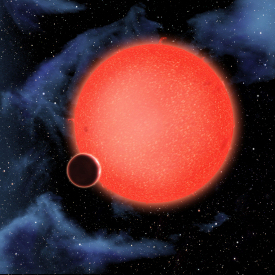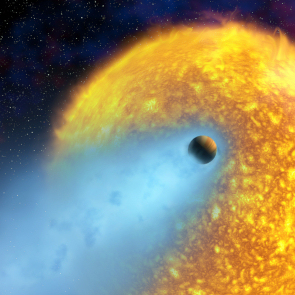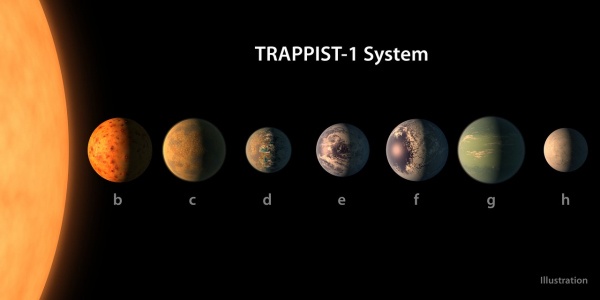A zoo of exoplanets
The existence of exoplanets is now established beyond doubt, and the different detection techniques probe the parameter space – mass, radius, orbit, eccentricity, etc. – occupied by the vast array of planets. However, each technique provides only a part of the bigger picture and follow-up observations are almost always needed to confirm the nature of the planet.
The picture that is emerging is of a realm of weird and wonderful exoplanets, many of which could previously only be imagined in science fiction. We also know that our Solar System, with its small rocky planets in the inner regions and the large gas and icy giants in the outer regions, is not the standard planetary system template.
Jupiter, the largest planet in our Solar System, is around 318 times the mass of the Earth, but it is still dwarfed by some of its exoplanetary cousins. A glance at the Extrasolar Planet Encyclopaedia reveals in excess of 20 confirmed exoplanets that have more than 50 times the mass of Jupiter. Many of these orbit close to their parent star, hence the term 'hot Jupiter', while others orbit much farther from their star than any of our planets do from the Sun.
 |
| Artist's impression of GJ 1214b. Credit: NASA, ESA, and D. Aguilar (Harvard-Smithsonian Center for Astrophysics) |
By far the vast majority of exoplanets that have been detected to date are of a size that appears to be absent from our Solar System. Dubbed "super-Earths" or "mini-Neptunes" they have masses between those of Earth and Neptune. Since for most of these exoplanets only the mass or the radius, but not both values, are known, it is not possible to determine if they are small and rocky Earth-like planets or slightly larger gas-enshrouded Neptune-like planets.
If the mass and radius have been determined it is possible to get an idea of the composition of a planet by comparing the calculated density to predictions from computer-generated models. In the case of potentially rocky worlds, a low-density could indicate an "ocean planet", one that is completely covered in oceans hundreds of kilometres deep. One such candidate is Gliese 1214b – a super-Earth with a density lower than Earth.
Another oddity is a potential diamond planet. The planets in our Solar System formed in a protoplanetary disc that was rich in silicon and oxygen, but models predict that it is possible that discs around other stars could be rich in carbon instead. Planets in these systems could have layers of graphite or diamonds depending on the pressure within the planet. Diamond planets are still only theoretical, although one possibility is the super-Earth 55 Cancri e as it has hints of a carbon-rich atmosphere.
 |
| Evaporating planet HD 209458b. Credit: European Space Agency, Alfred Vidal-Madjar (Institut d'Astrophysique de Paris, CNRS, France) and NASA |
If we could image the planet HD 209458b – the first planet measured via the transit method – it would resemble a giant comet. This is because the planet is so close to its host star that its atmosphere is evaporating, leaving a tail of material stretching out behind it in its orbit.
Terrestrial exoplanets orbiting close to their star would also feel the heat – both directly from the star as well as from tidal forces – and it is thought that "lava planets" could result. These are hypothetical planets where the entire surface would be molten rock. CoRoT-7b is a candidate for this type of planet.
In our Solar System the planets all have almost circular orbits, but some exoplanets have been discovered on extreme elliptical orbits. This indicates a violent dynamical past, where the planets likely had unstable gravitational interactions with other planets or stars. These types of interactions can eject planets from a system, while dramatically changing the orbits of the remaining planets.
Other orbital extremes have been revealed from the discovery of "misaligned planets". In the Solar System, the planets orbit roughly in a plane around the equator of the Sun – these are considered to be well aligned. But in other systems, the orbital plane of the planets is at a large angle with respect to the stellar equator (these are the "misaligned planets"), and some planets even orbit around the poles of the star rather than the equator.
 |
| Comparing the TRAPPIST-1 planets. Credit: NASA/R. Hurt/T. Pyle |
Clues to composition are in the atmospheres
To make progress in understanding how planets and planetary systems came to be it will be necessary to study not only the properties of individual planets but also their atmospheres. Planetary atmospheres are key to understanding what planets are made of, which in turn is essential for uncovering the most likely formation and evolution scenarios.
Elements in the atmospheres of exoplanets can be detected via two different methods. In one method, the light from the star passing through the planet's atmosphere can be absorbed by elements in the planet's atmosphere. This creates a deeper transit at particular wavelengths and can be used to reveal the presence of the molecules that have absorbed the light. The other method relies on observing the combined spectrum of the star and planet when both are visible, and again of the star only when the planet is behind the star. Subtracting the two will leave the spectrum of the planet, from which details of its atmosphere can be inferred.
The spectra of exoplanets obtained to date are not very detailed, however molecules such as water, carbon monoxide, and sodium have been detected. Other features in the atmosphere, such as clouds and hazes, can also be discerned. Although it is easiest to study the large, extended atmospheres of gas giants, atmospheres have been detected recently on terrestrial exoplanets. This is an important stepping-stone towards eventually detecting signs of potential life, as biosignatures in the atmospheres of the terrestrial planets might become detectable with improving technology
| Read more |
| 1: A brief introduction to exoplanets |
| 2: How to find an exoplanet - detection methods |
| 3: A zoo of exoplanets |
| 4: The future of exoplanet research |
